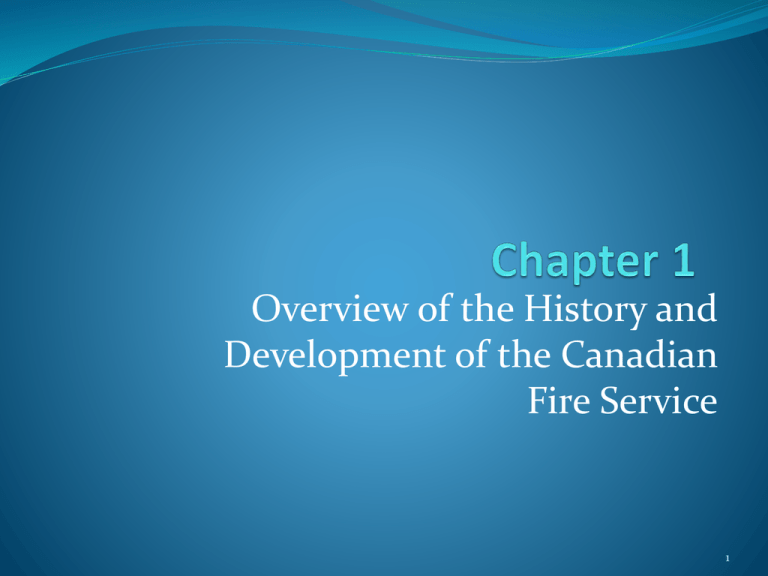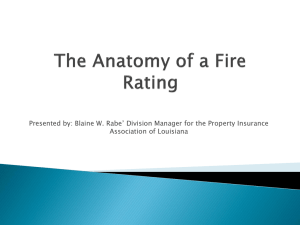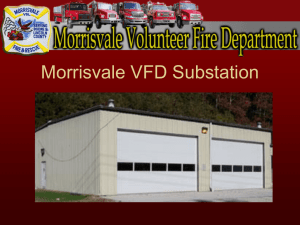Chapter 1 - Ontario Association of Fire Training Officers
advertisement

Overview of the History and Development of the Canadian Fire Service 1 Introduction This chapter covers: Importance of the mission of the fire service Purpose of a mission statement How the history of the fire service influences the modern day firefighter Fire service changes from 1947 to early twentyfirst century 2 The Mission of the Fire Service Mission synonymous with purpose for existence Legal authority to act in a certain manner Mission statement Written declaration describing things it intends to do to protect citizenry or customers Every individual responsible for mission Varies from very general to very specific 3 History of the Fire Service in Canada Firefighter tasks are the same all over the world. Save lives and property from fire and other emergencies. Different fire departments have different approaches. The Canadian fire service has always had a romantic image. 1.4 4 Fire Loss Record of North America The fire loss record of North America has been dismal compared to most of Europe. A 1918 report found that Canada had the worst life and property loss per capita in the world. Dependence upon fighting fire instead of preventing them Globalization of commerce and communication 5 Early Settlers Very vulnerable to fire Expediency over-ruled the fear of fire Profligate attitude towards forests they burned for agriculture and to the buildings they put up Conflagrations destroyed large parts of towns and cities became a drag on the development on a viable and comfortable community. 6 Early Fire Service Late 1700s: Fire insurance market to cover fire losses and begin community firefighting capability. Cities tried to control the threat of fires. Regulations, control of flammables, firefighting provisions, fire wardens Earliest firefighting measures were ineffectual. 7 Fire Insurance and Fire Engines Amsterdam fire engine consisted of a large, open topped box on wheels with a mounted twocylinder piston pump. Hand engine developed in 1721 by British Inventor Richard Newsham George and Alfred Perry built an engine in 1840 to compete in pumping contests. Great fire of London in 1666 stimulated the development of fire insurance and the first fire insurance companies. 8 Canada’s only major hand fire engine manufacturer was successful with engines for firefighting and competitions in mid nineteenth century. The Perry brothers were prominent volunteer firemen. 9 An example of the British style of engine donated by the British insurance companies to Canadian cities. The gooseneck nozzle on top has been replaced by a pipe leading down to connect with hose. 10 Fire Insurance and Fire Engines (cont.) Vancouver was born overnight in the 1880s, after the hand engine era was gone. Benjamin Franklin is considered the father of the American fire service. First half of 1800s, volunteer fire companies reigned supreme in all Canadian cities and towns. Alfred Perry was considered the father of the Canadian fire service. 11 Fire Insurance and Fire Engines (cont.) Mid-1800s: Cities and towns were growing much larger, bigger buildings and more densely built business districts Montreal had one ladder and nine engine companies. Toronto had one ladder, nine engine, two hose, and one salvage companies. Fire companies requiring large numbers of members Toronto and Montreal installed powerful water main systems with hydrants by 1861. 12 Steam Power and Career Firefighters 1860s: Hand and horse-drawn steam pumping engines were imported Halifax had the first steam fire engine in Canada, March 1861. Soda-acid extinguisher adopted in the form of hand-carried extinguishers and 40 to 60 gallon tanks on apparatus. Chemical tanks were installed on many hosewagons, called simply “the chemical.” 13 Steam Power and Career Firefighters (cont.) Before 1880, a need for power operated, longer ladder as buildings grew larger. 1891: Colleret ladder, by a Montreal fireman 1902: Seagrave spring-assist ladder Manually-raised ladder became obsolete American LaFrance used superior raising and rotating mechanisms. 1950s: Spring-hoist ladders remained in service in Canada. 14 Most cities passed through extended transitions from volunteers to career staff using an on-call force and skeleton staff. Here are the Engine 3 call men with their full-time drivers in Saint John, NB. 15 The Montreal Fire Department goes into action, advancing hose-lines laid by their wagon, while a fair damsel is caught in a life-net, all done for an early movie. 16 Auxiliaries Horse-drawn fire department utilized various auxiliary vehicles in support to the major apparatus. Fire departments operated specialized salvage companies for the purpose with their own vehicles. Specialized rescue or squad companies Fuel wagons supplied the steamers with coal. Chiefs had buggies with fast horses. 17 An assemblage of company apparatus in Hamilton, Ont., representing a typical city first alarm business district response. 18 The Hayburners Horses that were both strong and fast became the rule. Horse were stables located in the back of apparatus room. In 1919, Montreal operated 110 horse-drawn fire department vehicles. In 1912, Toronto operated 55 horse-drawn vehicles with 120 horses. 19 Gasoline Power Cities converted to gasoline rapidly. Victoria’s last horse retired in 1919. Lower maintenance cost was a strong element in the change. Costly in capital investment for aerial trucks and pumping engines Changeover began around 1910. 20 Gasoline Power (cont.) First custom chassis Seagrave AC type American LaFrance developed piston, rotary gear and centrifugal pumps. Functional capabilities of apparatus Triple combination Quadruple combination Quintuple combination 21 The front wheel drive configuration of this LaFrance springhoist aerial ladder truck was originally devised for conversion of horse-drawn aerials and engines. 22 A Seagrave centrifugal pumper on test. These reliable engines replaced steamers across Montreal in the 1920s. 23 Working Conditions The earliest career firefighters served under appalling conditions. No protective clothing Duty was “single platoon” World War I introduced shift or platoon plans in larger cities. The Depression brought some delays in capital expenditures, and working conditions were static. 24 Government Involvement 1918, federal government report on fire waste in Canada. Establishment of provincial fire commissioner or fire marshal offices Federal and provincial public education Fire research Enforcement of adequate building and fire prevention codes Manitoba had fire prevention legislation as early as 1876. 25 What the well dressed fireman wore in 1916, rubber turnout coat and a leather helmet, no breathing apparatus. 26 Modern firefighters benefit from better training and working conditions with shortened hours on the job and substantial benefits and protection. 27 Urban Physical Structure Cities and towns grew, hazards such as ignition and fuel for destructive fires also grew. Buildings became bigger, taller and fraught with new hazards. Conflagrations continued to occur. Metropolitan areas into countryside 28 Urban Physical Structure (cont.) Numerous serious life losses occurred in institutional occupancies of nineteenthcentury construction. New difficulties: Foam plastics in buildings; introduction of light weight components Growing cities saw the increased use of tall or high-rise buildings. 29 Firefighters work to contain a blaze in a commercial building. 30 Firefighters work to ventilate a roof using modern tools. 31 The Technological Era Progress of technology has great effect on urban and rural fire protection. Communication is improved. Automatic detection and extinguishment both gives warning and makes the home owner aware of the fire threat. Availability of breathing apparatus derived from the diver’s aqualung. Infrared fire detection Emergency medical devices 32 Fireground commander transmitting orders via a radio. 33 Winnipeg firefighters try on three types of breathing apparatus. 34 The Technological Era (cont.) Weak management and reluctance to change held back many improvements. Sophisticated technology and management History teaches us that a mission, planning and persistence are required to pursue advancement of the fire service in the face of resistance by the public it protects. Education is vital in achieving an appropriate level of fire safety in the community, education both for the firefighter and for the citizenry. Growing technology is vital. 35 Lessons Learned The Fire Service in Canada has a long and storied history. Firefighters are an important piece of the protection and response component available to our communities. We must give due credit to the past. Future contains difficult challenges and opportunities. Firefighters must develop skills that did not exist previously. The motto of the Roman fire brigade was “Semper Vigilans,” or “Always Vigilant.” 36








